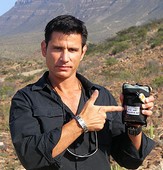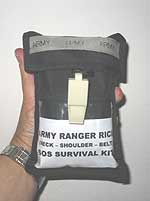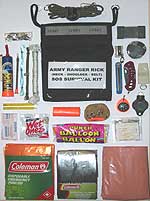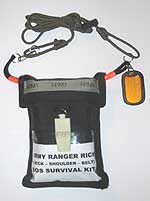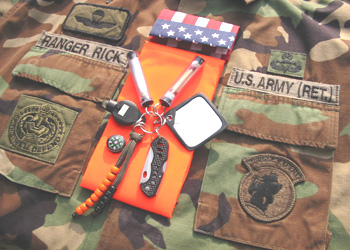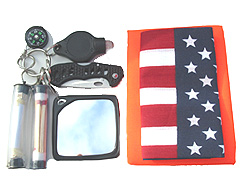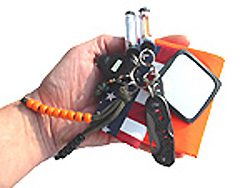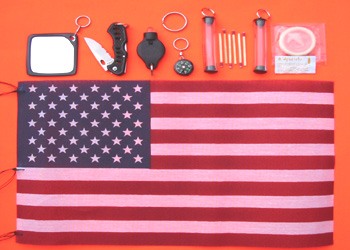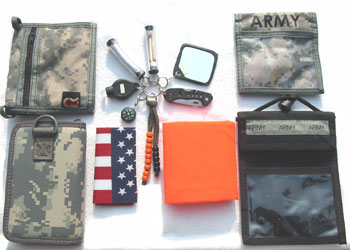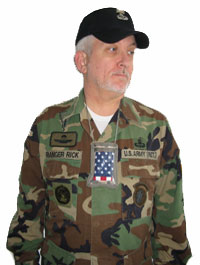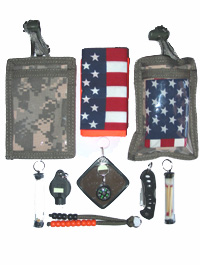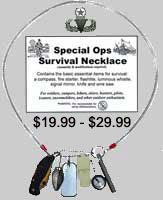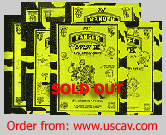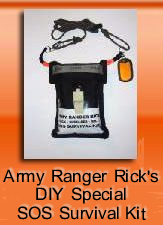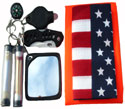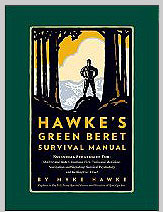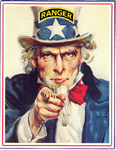
|
|||||||||||||||||||||||||||||||||||||||||
|
Here ya go boys & girls, I guarantee ya won't find a more useful, multi-purpose, lightweight survival kit than this, developed by yours truly "Army Ranger Rick." And the best thing about it is you can put together this kit yourself and it weighs just 16 ozs. Really! The Carrying Case - It's one of those nylon "neck wallets" that you can purchase from almost any military/outdoor supply store. All I did was slightly modify it by sewing in two 4 inch pieces of paracord to the back side of it so you can wear it on your belt. And another 6 foot piece of paracord across the top so that you can either wear it across your shoulder or around your waist. And if necessary, you can remove it in a survival situation to make yourself a "fire bow" or a "hunting bow." Smart, huh? And here's what I was able to pack & stuff inside of it, but I gotta warn you it wasn't easy. 1 - Small Compass - General direction type. 2 - Emergency Space Blanket - Lighweight, pocket type. 3 - Emergency Poncho - Lightweight, pocket type. 4 - Signal Whistle - Any type will do. 5 - Wire Saw - BCB International. 6 - Signal Mirror - One or three piece type. 7 - Pocket Knife - Folding type, w/serrated blade. 8 - LED Flashlight - Extra batteries attached to it with tape. 9 - Orange Duct Tape - 30 inches, used for marking trails, first aid bandage, etc. 10 - Magnesium & Flint Fire Starter - Remove the metal striker and use the knife to strike the flint side to start your fires. 14 - Condoms & Purification Tablets - 2 x condoms & 8 x water purification tablets 15 - Thick Rubber Bands - When attached together they can be used to make an improvised weapon such as a sling-shot, spear gun or cross bow. 16 - Orange Toy Punching Balloon - Can be used when blown up as a signaling device and as an improvised flotation device too. 17 - Snare Kit - 12 x feet of wire along with 5 mini split rings and or swivels for making animal traps & snares 18 - Fishing Kit - 20 x feet of fishing line, 6 x assorted hooks, swivels and 5 x screw eyelets for making an improvised fishing pole or setting up a trout line. 19 - Cement Nails - Assorted sizes, used to make fishing and hunting spears, arrow heads, etc. 20 - Band Aids - For first aid uses 21 - Pencil Sharpener - Use it to make "paper thin" tinder sheets for starting fires. 22 - Trick Birthday Candle - Once lite, can't blow it out, great for starting fires when it's windy. 23 - Wet Ones - For cleaning cuts, injuries and can be used for igniting fires too. NOTE: Feel free to share this do-it-yourself survival kit idea with others, provided you let'em know where you got it from, yours truly "Army Ranger Rick" at www.SurvivalOutdoorSkills.com .
SMA Survival Kit For Soldiers
Note: Developed in honor of the 173 rd Airborne "Recon/Scout Platoons" down range in Afghn (2010). When you join the Army, Navy, Marines or Air Force, unless you're a pilot or a member of an elite special operations unit you won't be issued a personal military survival kit. Why? Because they are only issued to those who operate behind enemy lines and in remote & isolated areas of the world far from civilizations. And if you're not a pilot or a member of a special ops unit, does this mean you don't need a personal survival kit? Absolutely not! In fact whether you're assigned to a conventional unit (infantry, armor, transportation, etc) or an unconventional unit (Special Forces, Ranger, etc), regardless of your MOS you should still pack & carry a person survival kit. What should a personal military survival kit contain? Well it depends on two things; (a) the type of terrain, weather & environment you'll be operating in and (b) your knowledge, skills & experience in knowing how to survive in the outdoors.
And so as a general rule; the more experience & knowledge you have in survival - the less items you need. But the less experience & knowledge, the more survival items you should pack & carry. Make sense? You betcha. Where should a survival kit be carried? The best place is somewhere close and near your body like in one of your shirt or pants pockets or attached to your belt. Why? So in the event you have to ditch & drop your ruck and or some other military gear you will still have your survival kit on you. Again, make sense? Yep, sure does. Though pilots, aircrews and special operation forces need to pack & carry a vast assortment of survival gear so they'll be prepared for almost any type of environment. The following is a basic list of items all soldiers regardless of their MOS should pack & carry in their own personal survival kit.
These are just a few of the basic "must have" survival items all soldiers should pack & carry in their personal kit just in case they find themselves lost or separated from their unit down range in "bad guy" land. What should these items be carried in? Well definitely not in one of those tin can or plastic storage containers as they could make some unwanted rattling noise while moving around in hostile terrority. So instead it's best to pack & carry them inside a soft military pouch or wallet so they won't make any noise and will be easier to store inside your pocket or on your belt.
Remember.Better to pack & carry a few survival items and maybe never having to use them than not to have any at all and wished you had. Some good advice? You betcha!
|
||||||||||||||||||||||||||||||||||||||||
|
Check Out SF Myke's Book! Click here. Why It Pay$ To Join Wanna Website Like This? Contact:
|
|||||||||||||||||||||||||||||||||||||||||
| © 2008 by Survival Outdoor Skills, All Rights Reserved. |

